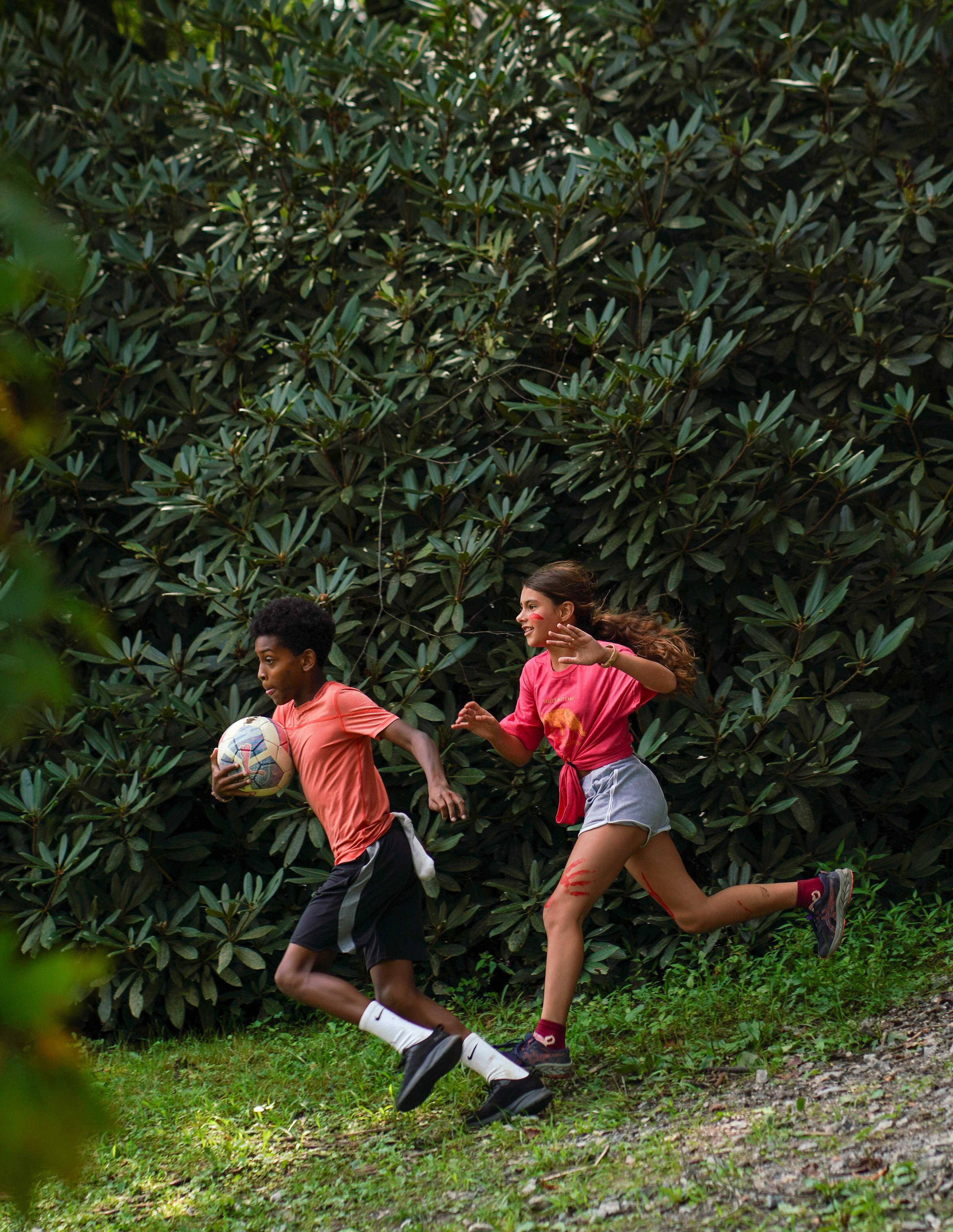

THE EAGLE
[FALL 2025] Participant Perspective
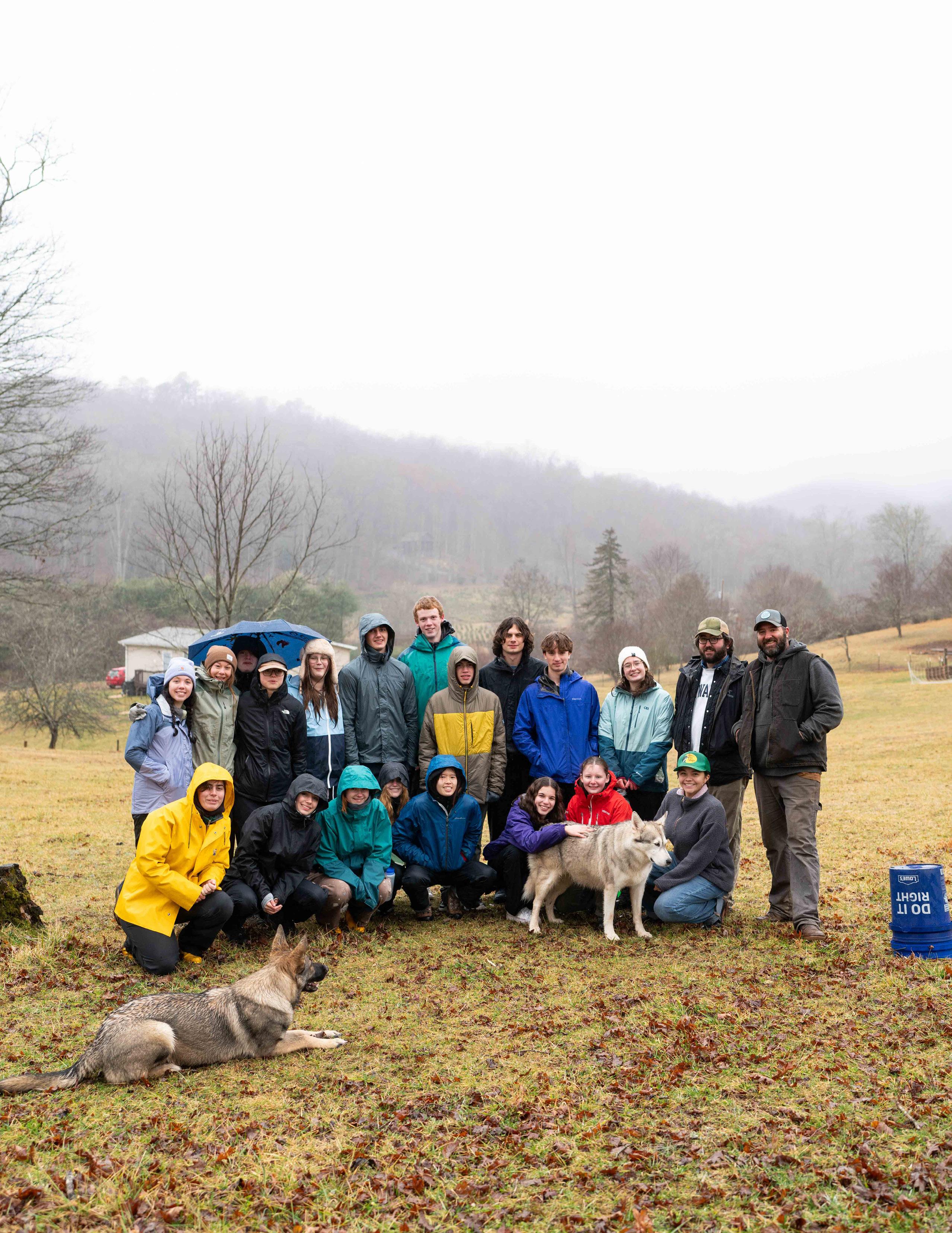

Grazers Glade Mountain Ranch
EDITOR’S NOTE
Dive deeper into Eagle’s Nest Foundation’s programs and better understand the immersive and impactful experiences from a participant’s perspective at Eagle’s Nest Camp, Hante Adventures, and The Outdoor Academy.
I hope you enjoy reading these thoughtful stories about the impacts of experiential education for young people at Eagle’s Nest Foundation.
-CAMILLE WICK, ANNUAL FUND MANAGER
FINDING YOUR COCOON - P.4
Did you hear about Lavern and Earl from this past summer? Now’s your chance to meet them and learn more from Camp Director Ellen Fox about the transformations campers go through each summer to discover their best selves.
STORY IS THE WEAVING - P.8
Have you ever wondered what goes into planning an international Hante? Read about the extensive scouting trip to Scotland Executive Director Beth Venable chronicled, complete with majestic views and the inevitable road bumps along the way.
ONE YEAR LATER- P.12
The one year anniversary of Hurricane Helene has brought back many emotions. OA Director Jesse Pyles describes staff and students’ boots on the ground impact and how strong connection and close-knit community weathered the devastating natural disaster.
NEST CHATTER - P.11, P.16
Read more about alumni connections beyond 43 Hart Road from long-time Camp and Hante participant Adam Guy.
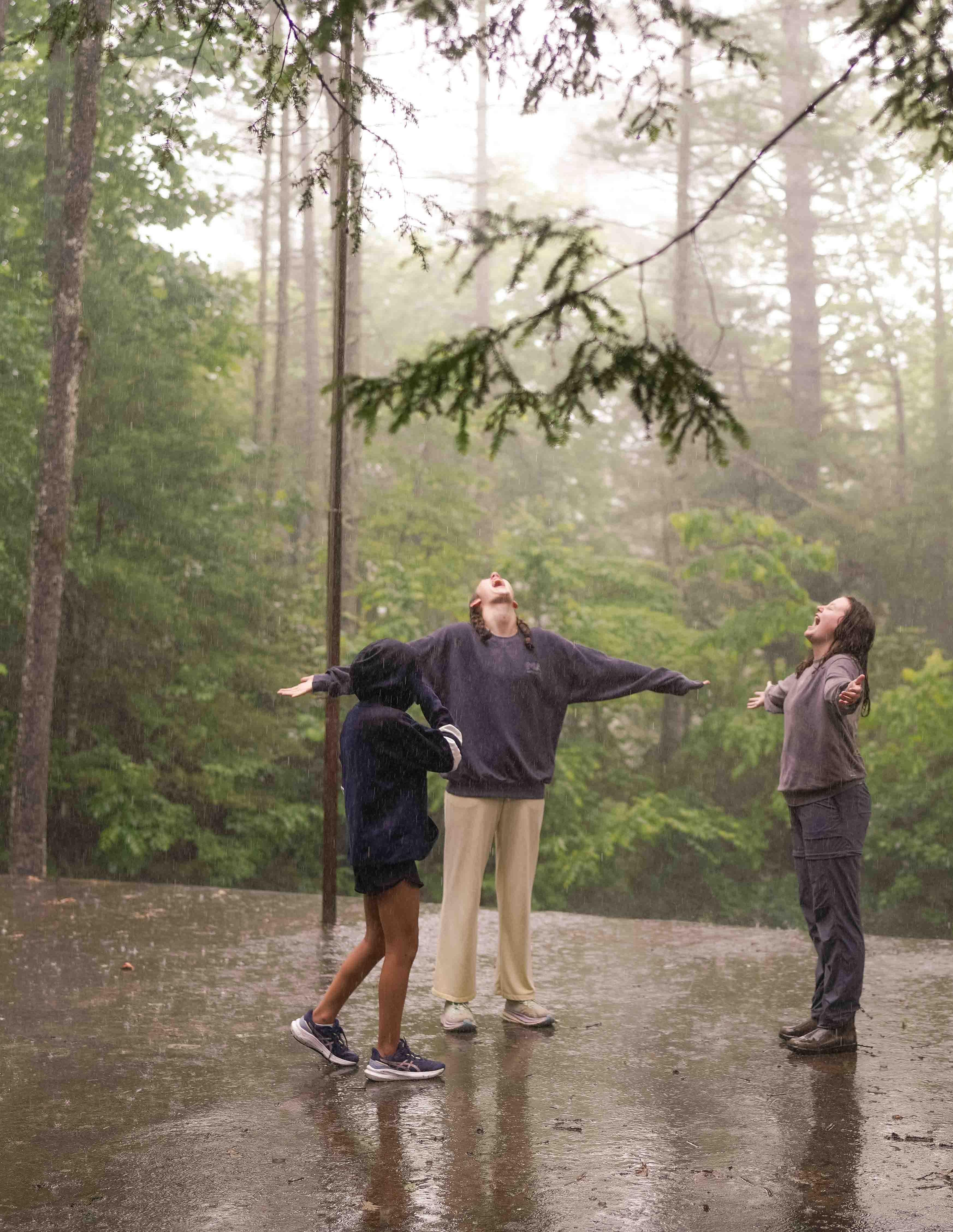
FINDING YOUR COCOON
Ellen Fox, Camp Director

he bell rings at 7:30 a.m., and an inflatable 5’9” caterpillar shuffles into your cabin as your eyes adjust to the morning light. In an impressively ambiguous Dutch-GermanRussian accent, you hear the caterpillar shout, “I am Lavern the Cat-uh-pilla. I am looking for a place to ca-coon. My parents dropped me awff heyah and I do not know what I am doing… Help, someone, please help me.” You and your cabinmates jump down from your bunks to offer places for Lavern to cocoon.
“Up there,” you gesture to the rafters, “Usually the cocoons are hanging from something tall.”
“But I am scared of heights!”
cries Lavern. “What about in this bottom bunk?” your cabinmate suggests, pointing at a rumpled blanket and sheets.
“Someone is clearly already ca-cooning there,”
Lavern wails. “Is that Ellen?” another kid asks, poking Lavern’s side.
The crisis heightens as Lavern leaves in distress to search campus high and low, terrified they will never find the place—or the courage—to build a cocoon. You and your cabinmates say goodbye and begin getting ready for Flagraising.
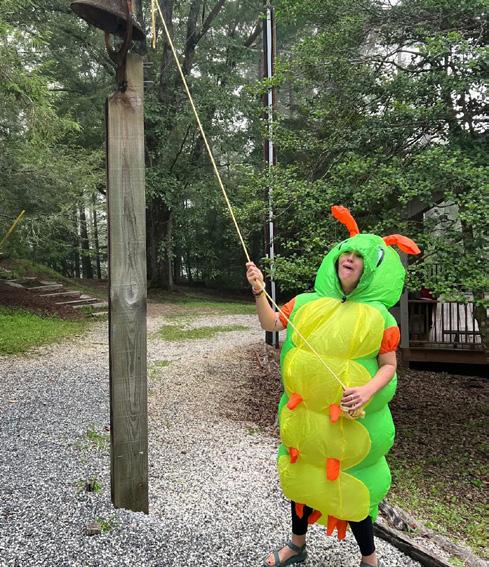
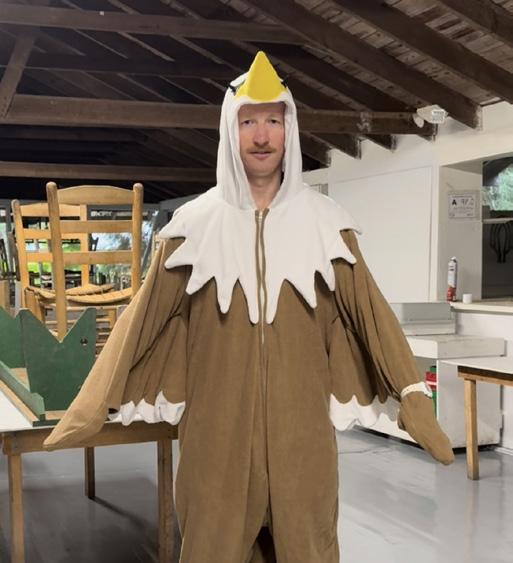
Earl the Bird swoops into the Dining Hall near the end of breakfast, punctual as ever. While he is confident, his decision-making is often rash and impulsive, leading to things he later regrets. Because of this, Earl is often a loner, out on his own. Earl spots Lavern across the tables and swoops in. His southern accent drawls, “Early Bird gets the worm…!” Lavern shrieks as Earl wraps his talons around him—“I am no worm! It’s pronounced LA-VERN!” The two talk out the misunderstanding and soon become the support the other needed to grow.
Lavern eventually is able to cocoon (in a sleeping bag), despite never having done it before—all it took was some self-belief and determination. Earl found that Lavern’s self-regulating tactics, and simply having someone to share his feelings with, helped him feel more grounded and present. Eventually, on the last day of camp, Lavern emerges from the sleeping-bag cocoon and debriefs the “fever dream” to Earl. A new challenge arises: Lavern doesn’t know how to fly! But before panic sets in, Earl reminds Lavern that he has already done hard things—just now! The two fly out of the Dining Hall and into the future: braver, kinder, more independent, and not alone.
Sound familiar?! Lavern and Earl became mascots for two experiences we see in many campers. While their actions (and accents) are exaggerated, the metaphor of coming to a new, diverse space, trying to find one’s place, and doing something you’ve never done before… is anything but an exaggeration.
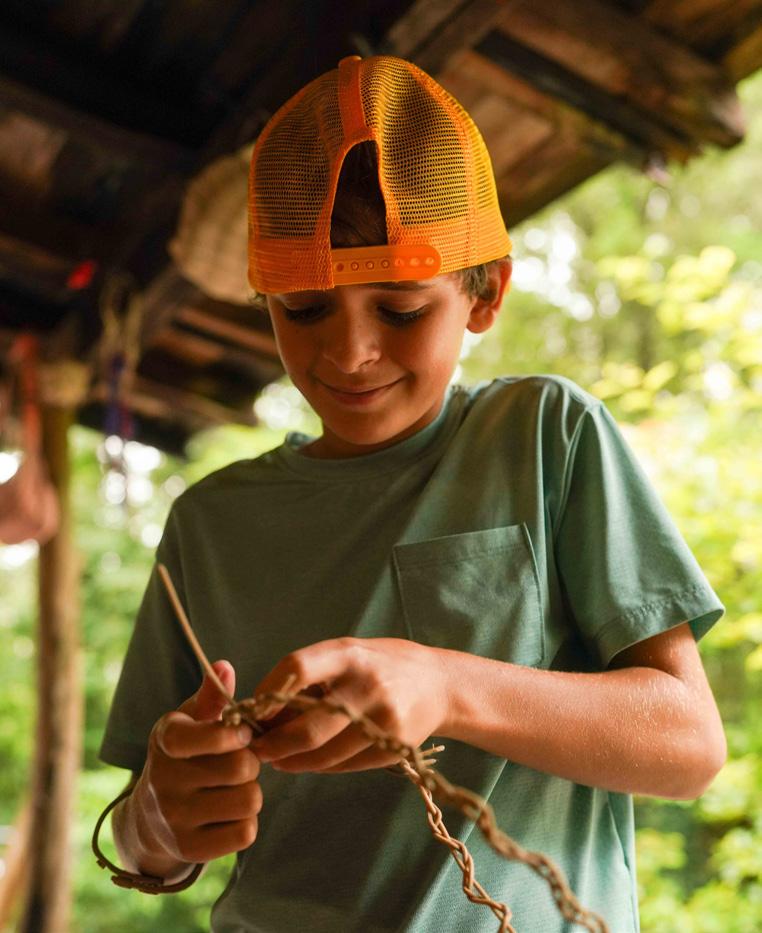
Coming to a sleepaway camp is a leap of faith. For many campers, it’s their first time away from home, surrounded by people they don’t know, and faced with challenges they’ve never attempted. Like Lavern and Earl, they arrive unsure, hesitant, or maybe overconfident but isolated. They are asked to try new things—performing in front of others, rock climbing, sleeping in the woods, crafting out of clay, or simply living in community with peers. These experiences stretch them beyond their comfort zones.
But just as Lavern found Earl, and Earl found Lavern, campers discover that they don’t face these challenges alone. They are supported by friends, counselors, and a whole camp community that believes in them. In that support, they learn not only that they can do hard things, but that doing them together makes the experience richer and more lasting.
At camp, adversity and novelty aren’t obstacles to avoid- they are the very soil in which growth takes root. By the end of the session, our Laverns and Earls head home transformed: more resilient, more compassionate, more confident. Like the caterpillar who learned to fly, they take with them the belief that hard things are not only possible, but worth doing.
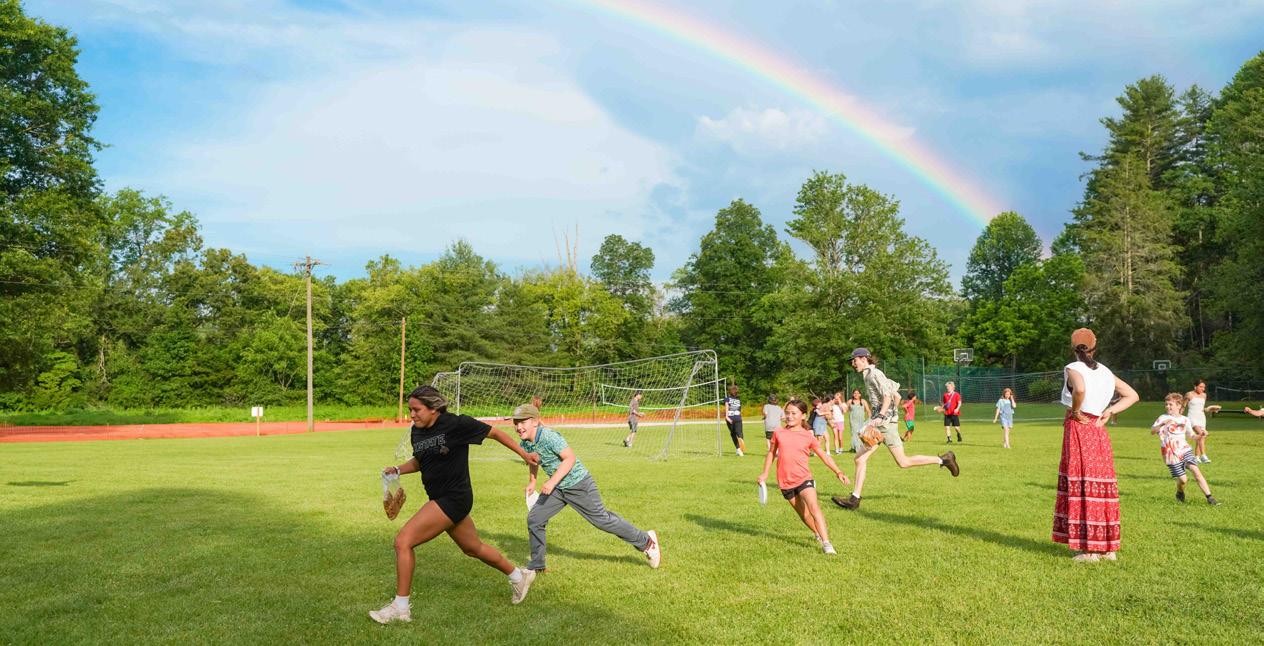
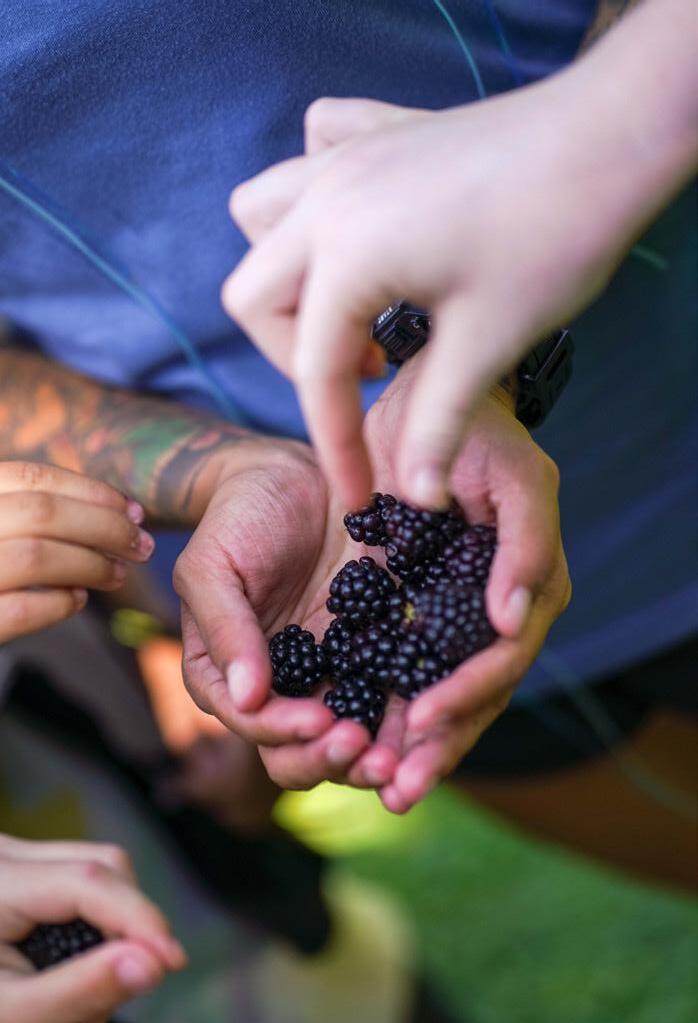
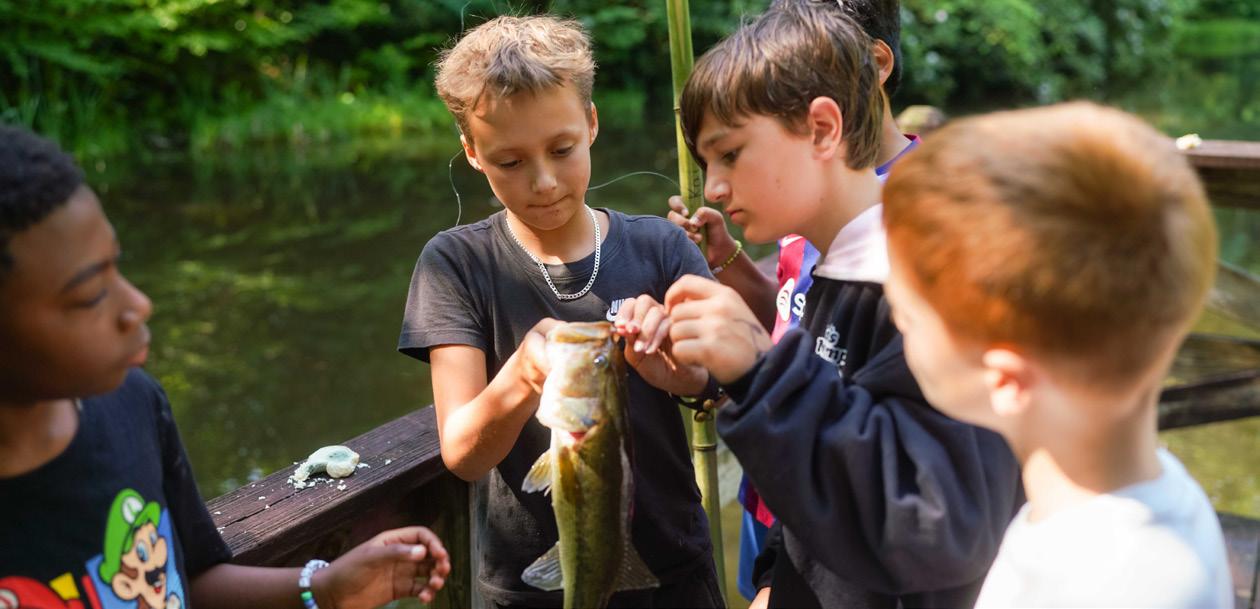

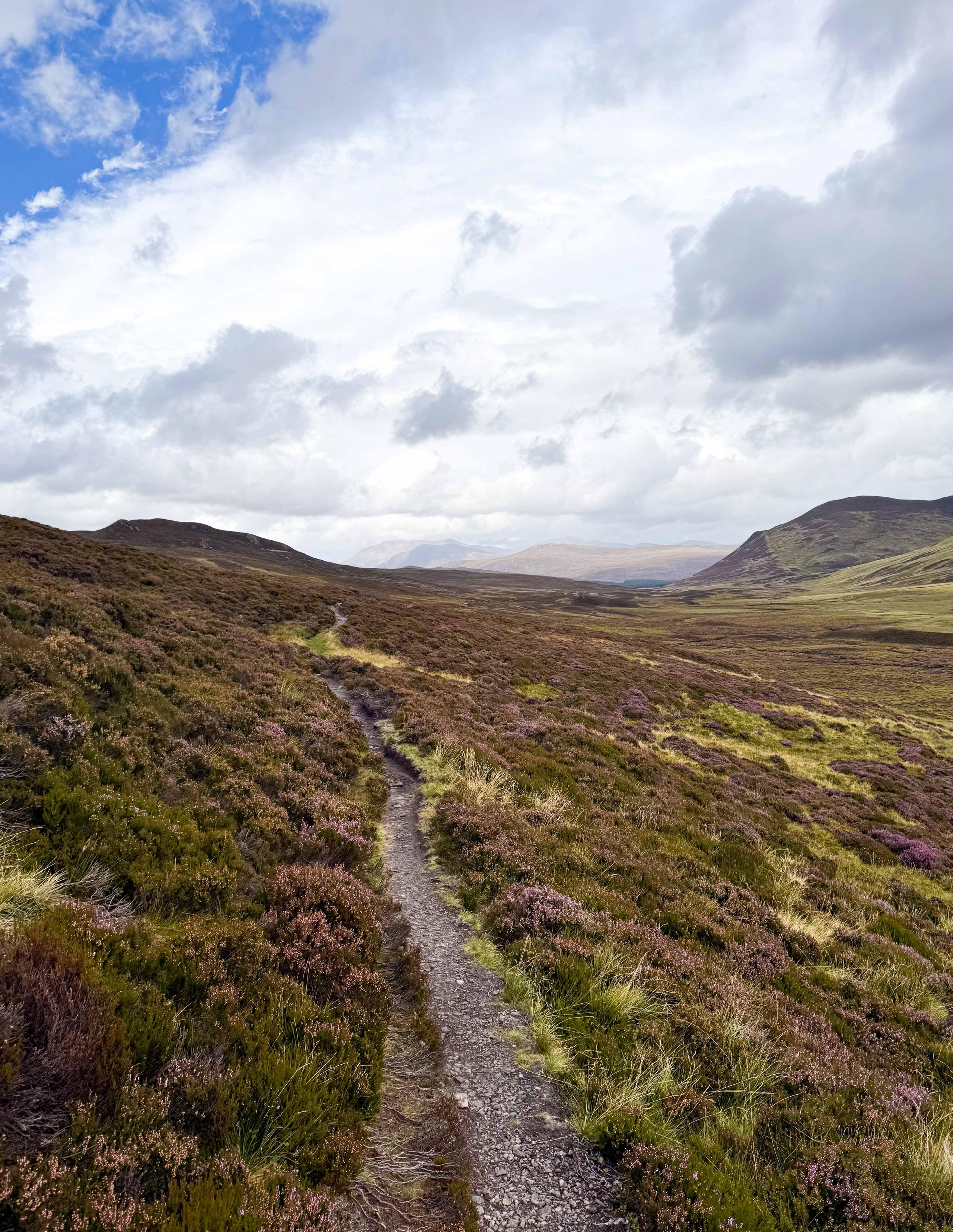

Cairngorms National Park
STORY IS THE WEAVING
Beth Venable, Executive Director
“There’s your plan, and then there’s the plan”
mentor used to share frequently. Perhaps this phrase rankled because I am very fond of “plan A.” This fondness also frequently leads to clinging a little too strongly to the OG plan, and very reluctantly prying loose so that THE plan has space to emerge. This is where I found myself on day four of scouting the Hante Scotland route, exhausted from working too hard to make the distance goal and missing the value of the experience. More specifically, rolling through a beautiful stretch of single track lined with purple wildflowers, overlooking the Cawdor River (and not at all suitable for bikepacking!) while yelling, “What is the point of this?!”
Thankfully, Scotland is riddled with castles and at many of these castles there are little outposts to offer refreshments to weary travelers like ourselves. Tucked in near Cawdor Castle, selfsoothing with a scoop of “banoffee” and caramel ice cream we wrote down four words: Immersive; Wild; Empowering; and Creative. These four words would form the framework for our decision making for the remainder of the journey, especially the 4th.

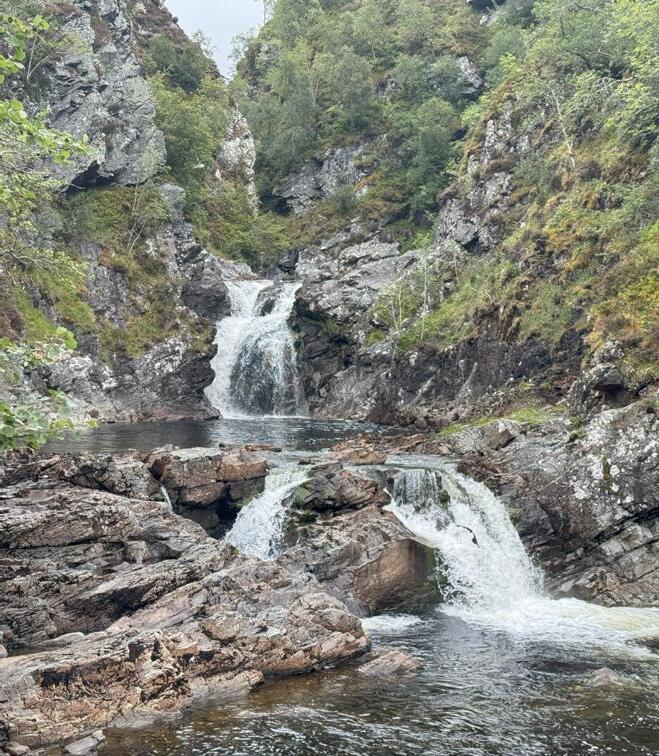
Making room for creativity, for storytelling, drawing, watercolor, simply taking it all in is an important distinction. It’s the creative processing that moves us out of a consumer mindset, ticking our boxes of accomplishments and scenery, and into a reflective and curious stance. Adopting the perspective of a Hante Scotland participant, tasked with writing a story inspired by their adventure, meant seeing and hearing stories everywhere. Simple questions emerged while pedaling. What lives in a bog, I wondered? How did that “Wee House” (pronounced “hoose”) get out to that small island? Hours passed easily imagining the rhyming couplets of books for younger children about the antics of animals in these wild places.
The more complex stories of people, culture, geology, and botany that mirror so many of our own here in Appalachia also threaded themselves into the experience. I was curious if there was overlap between the removal of native peoples from our Blue Ridge Mountains and the forced emigration of Scots known as the Clearances. How does this sit in the bones of our cultures? How does this influence the ways we tell our stories?
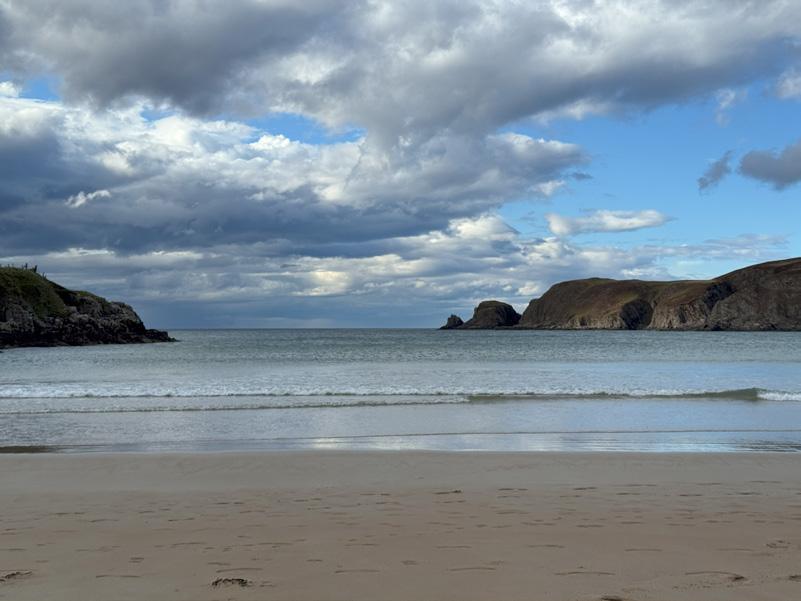
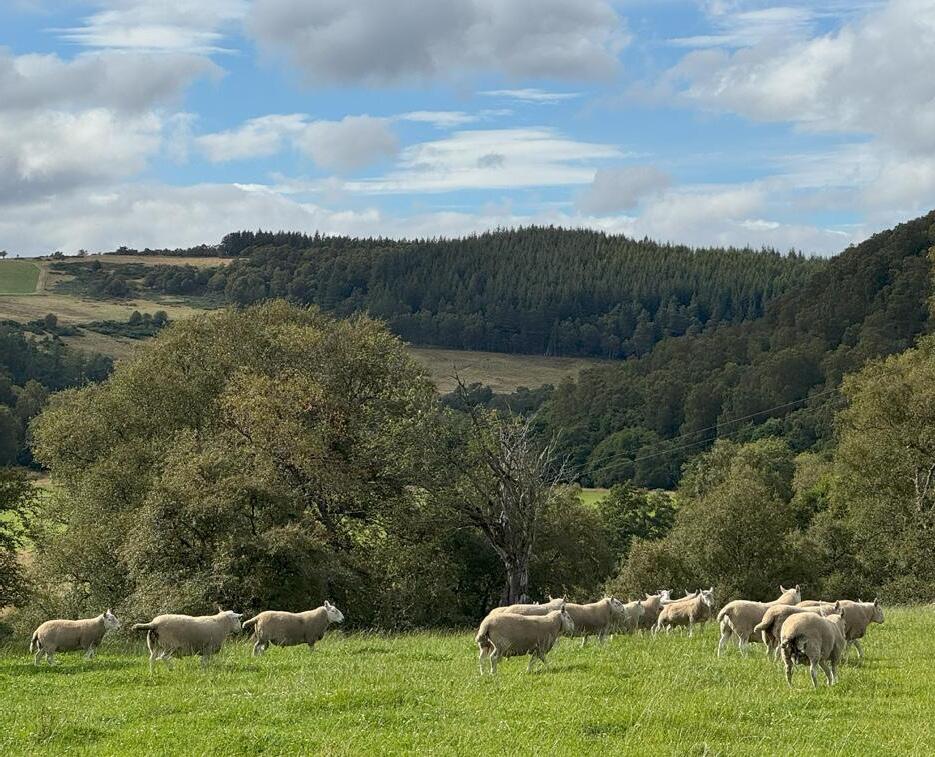
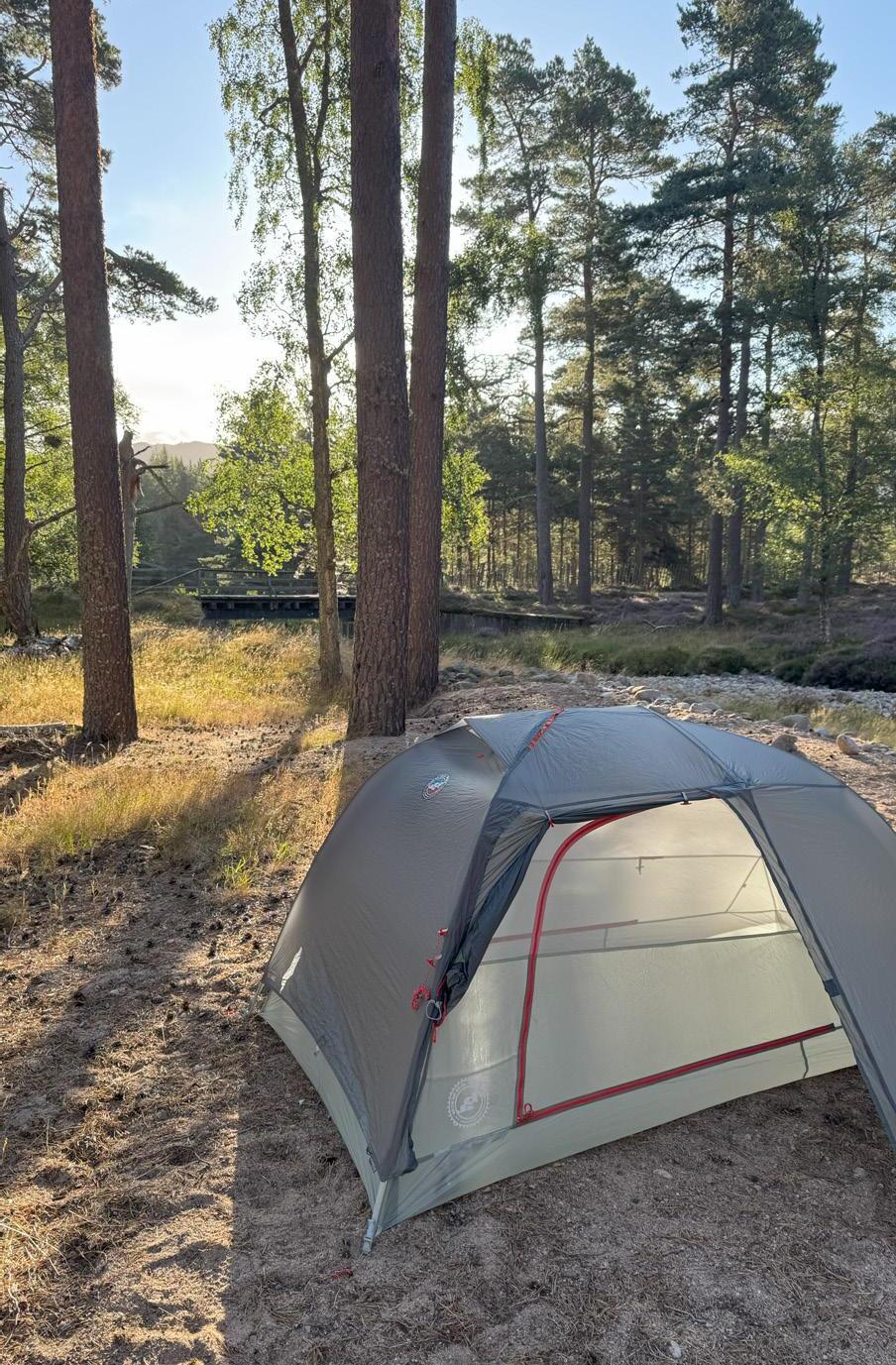
Like the stitching together of a quilt, the experience became more immersive, more wild, and more empowering because of the element of creativity. Looking back through writing, sketching from memory, and sharing personal experiences I was surprised to realize that the hardest part of the journey was the piece I wanted most to return to. This was a stretch early in the trip deep in the Cairngorms National Park and not on any of the biking heat maps, a gamble
in our planning. As it happens, it can only be walked slowly. Focusing on the number of miles we “needed” to complete that day meant less presence and appreciation for the spectacular moment we were in.
The great gift of a scouting trip is the opportunity to return, this time with a plan that includes more time to sink deeper, weave the tale, and fully inhabit the plan that emerges.
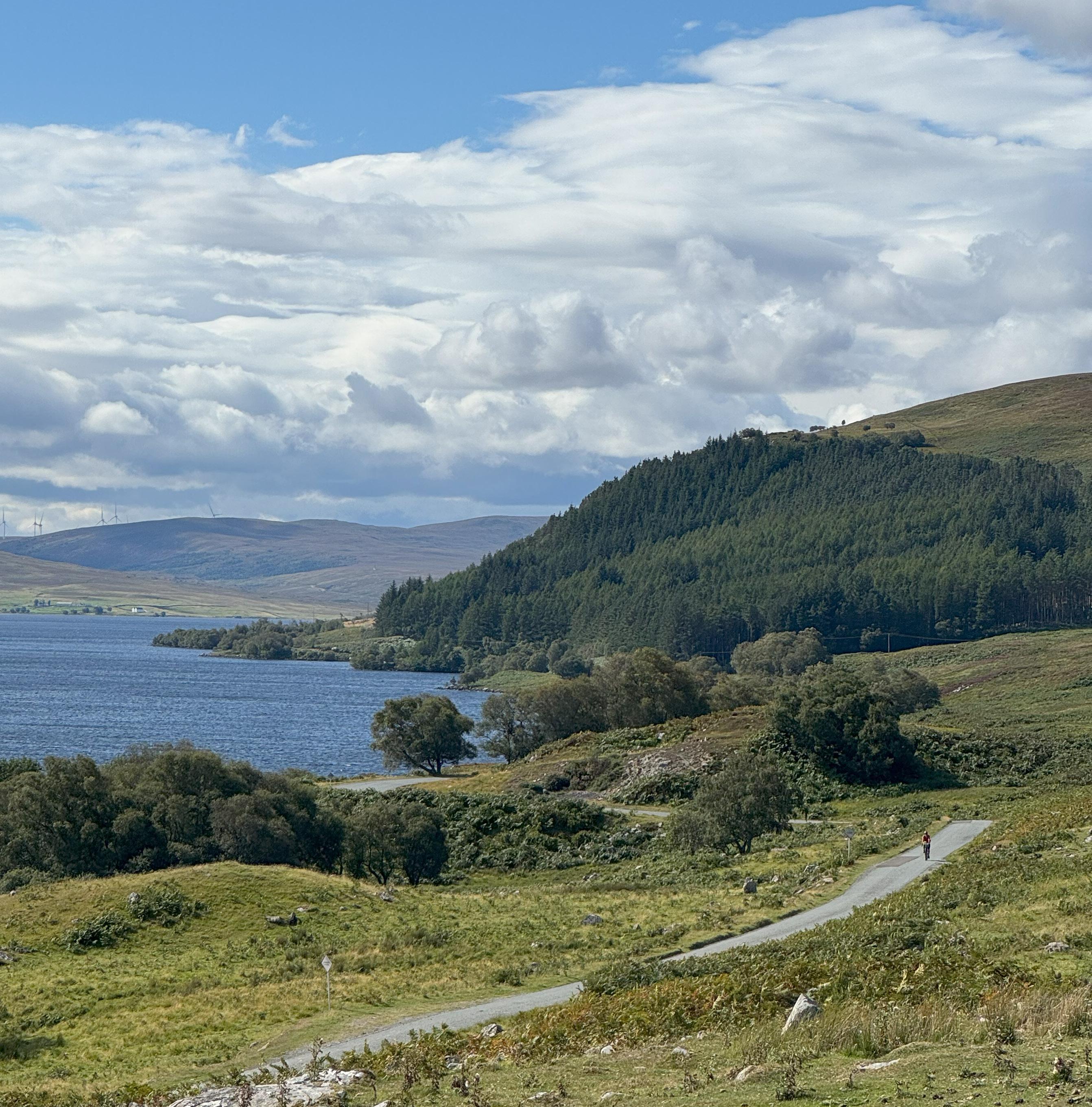
enf.org/hante-adventures-2026
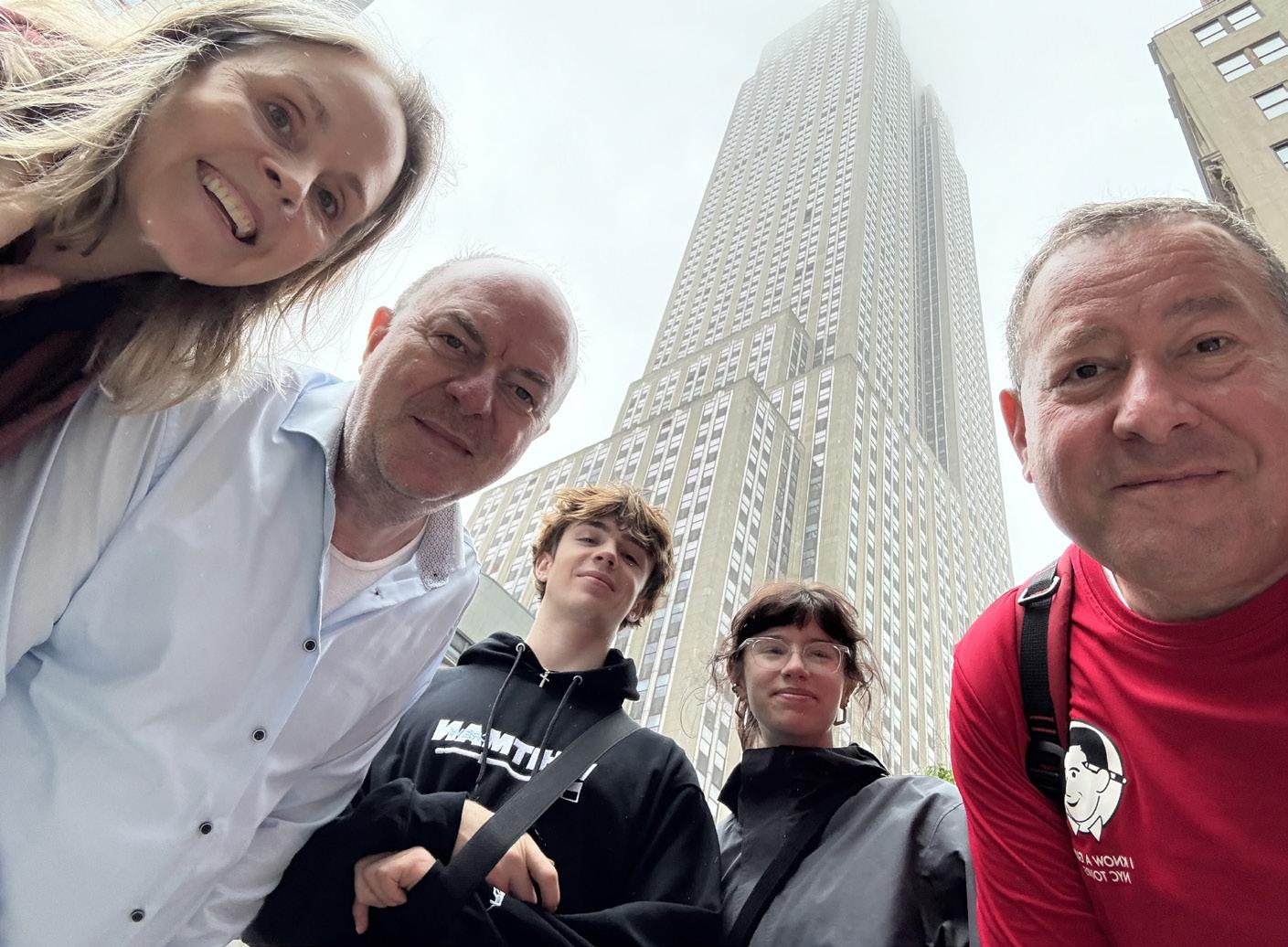
ast year, I donated to ENF’s annual silent auction. I run a tour company in New York City and offered a tour with me for bidding. Someone named Roman placed the winning bid. Camille notified me of the winner and also mentioned that Roman’s wife happened to be an ENF Board member named Dee. I didn’t know Roman, but I knew EXACTLY who Dee was – Dee Smith – and was thrilled at the realization that I would see her once again.
I grew up in Orlando, Florida with Dee, attending the same elementary and high schools with her. She was two grades above me, but both schools were small, the kinds of places where everyone knew everyone. Dee and I also attended Eagle’s Nest Camp together for years, including being a part of the first ever Sea Islands Adventure.
After high school, Dee and I lost touch. She went to college and then disappeared into one of those unusual jobs that moves someone around the world every few years. She’s in one place now and on to new career endeavors.
This summer, Dee, Roman, son Peter, and daughter Romy, came for their Big Apple tour with me. When I arrived at her hotel, we gave each other a big hug, and she introduced me to her family. That’s when I pulled out my elementary school yearbook! Her family was enthralled at seeing mom’s photo from the fourth grade.

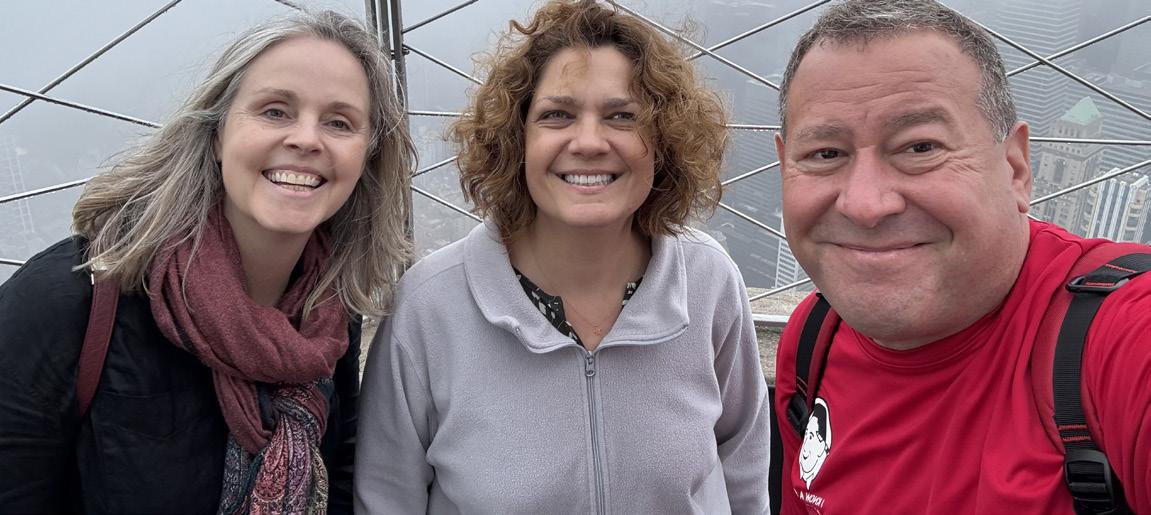
The five of us went to the Empire State Building, where my wife Janet works. And because I met Janet at camp, the two knew each other, too. That gave Dee and Janet time to reconnect. Janet arranged for us to go to the building’s 102nd floor observation deck. Even though it was cloudy and there was little visibility, no one cared. We were all glad to be there, having fun together. For Dee, Janet, and me, it felt like old times.
It was an AMAZING DAY. While I cozied up to each member of the family – making dad jokes with Romy, chatting about college admissions with Peter, and inventing believable, yet fake stories with husband Roman, Dee and I got a full day to reconnect, and it was wonderful.
Even though many of the people you meet at camp or school will disappear into their future lives, the connections we forge as children and teenagers are imprinted inside us. Keeping those connections alive takes effort (and maybe a bit of ENF auction magic in this case), but worth every text, email, and phone call.
I encourage all of you to reach out to an old camp or OA friend. Even if just to say hello or “I was thinking of you.” It will mean the world to that person. Trust me on this one.
Adam Guy, Camp Alumni

ONE YEAR LATER
Jesse Pyles, The Outdoor Academy Director

arly each semester, we ask students to draft and recite their Where I’m From poems. The assignment is a great introduction to our environmental humanities curriculum, integrating elements of writing and storytelling with observations, natural history, and the built environment. Students lean on the freedom of poetry as a writing form to explore elements of their family, their upbringing, and the places they call “home” -- especially important as they -- many for the first time -- find themselves newly considering their identities apart from or away from the home they’ve always known. The poems are also a tremendous introduction of each student to this newly forming community. The author gets to pick and choose the elements of their story that they want to share. The recitations are often an early moment of vulnerability, and an invitation to be deeply known by their peers.
As with so much of The Outdoor Academy, we ask the faculty to also do the work, revising and sharing our own Where I’m From poems during our faculty training sessions. My poem inevitably references the big Ohio River of my youth: how it dominated my sense of direction, my understanding of industry, health, and nature. Growing up on the big river taught me about cycles and about community. When the river came up, we all pitched in.
Fast-forward several decades, and those cycles, exacerbated and less predictable on a warming planet, came to bear last year with tremendous impact on the Little River and our adjacent Eagle’s Nest campus, my new home, and home to the students of The Outdoor Academy’s 59th semester.

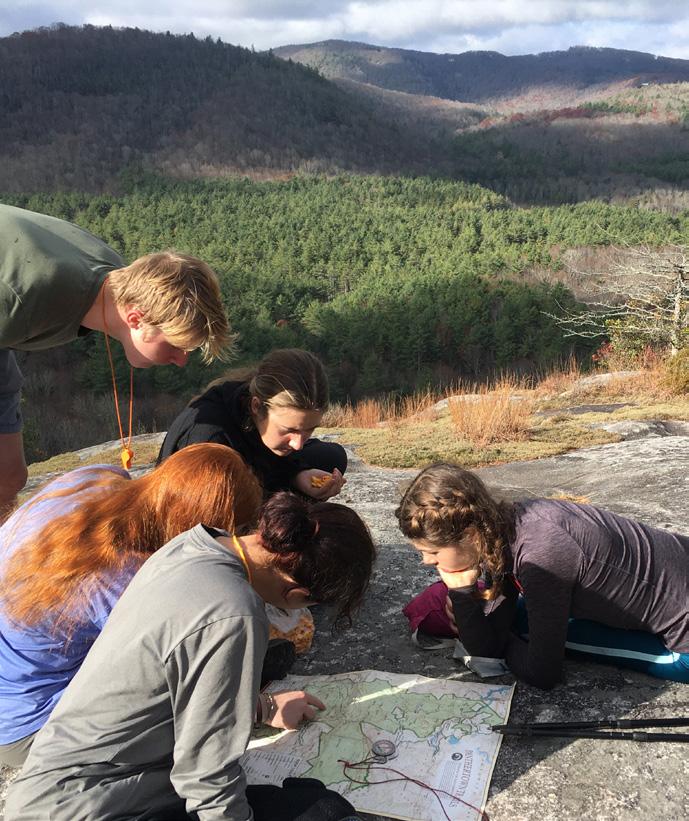
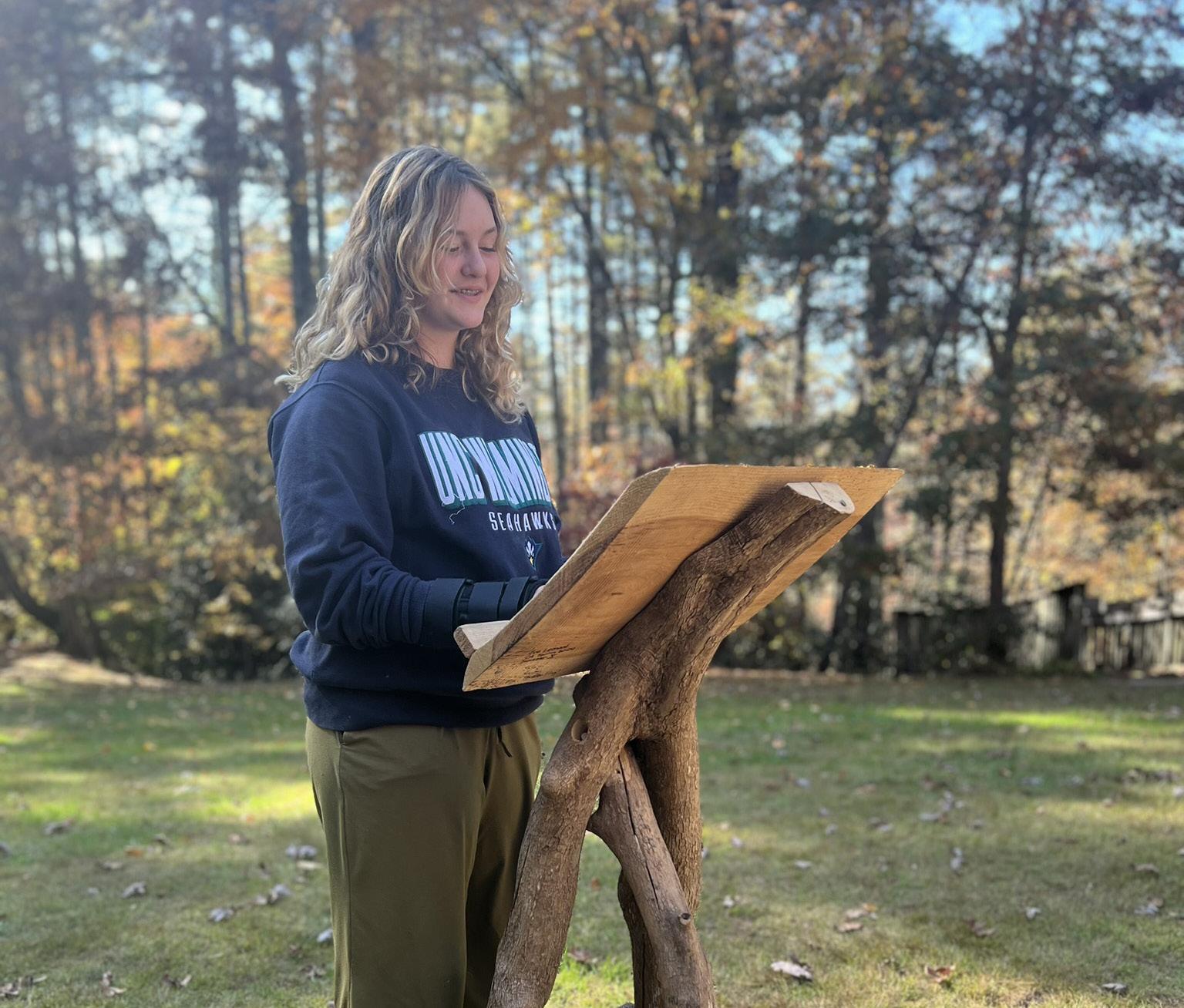
Hurricane Helene’s rain -- and the torrential rain that preceded it -- fell on campus, filling the streams and ponds that feed the Little River and the French Broad River beyond. Over 18 inches of rain in just a few days over a much broader area filled all such mountain tributaries that flow into these rivers, raising the French Broad River over 20 feet at the nearby monitoring station and to a record-breaking 24.67 feet in Asheville’s River Arts District just 40 miles away. On campus, the accompanying winds caused trees to topple, but mostly spared our buildings. The rising waters flooded the lower end of campus, including our athletic field, our garden and all the way up to our swimming lake, even dislodging our swim shed, campus fencing, and the footbridge over the Eagle’s Nest creek that empties into the Little River.
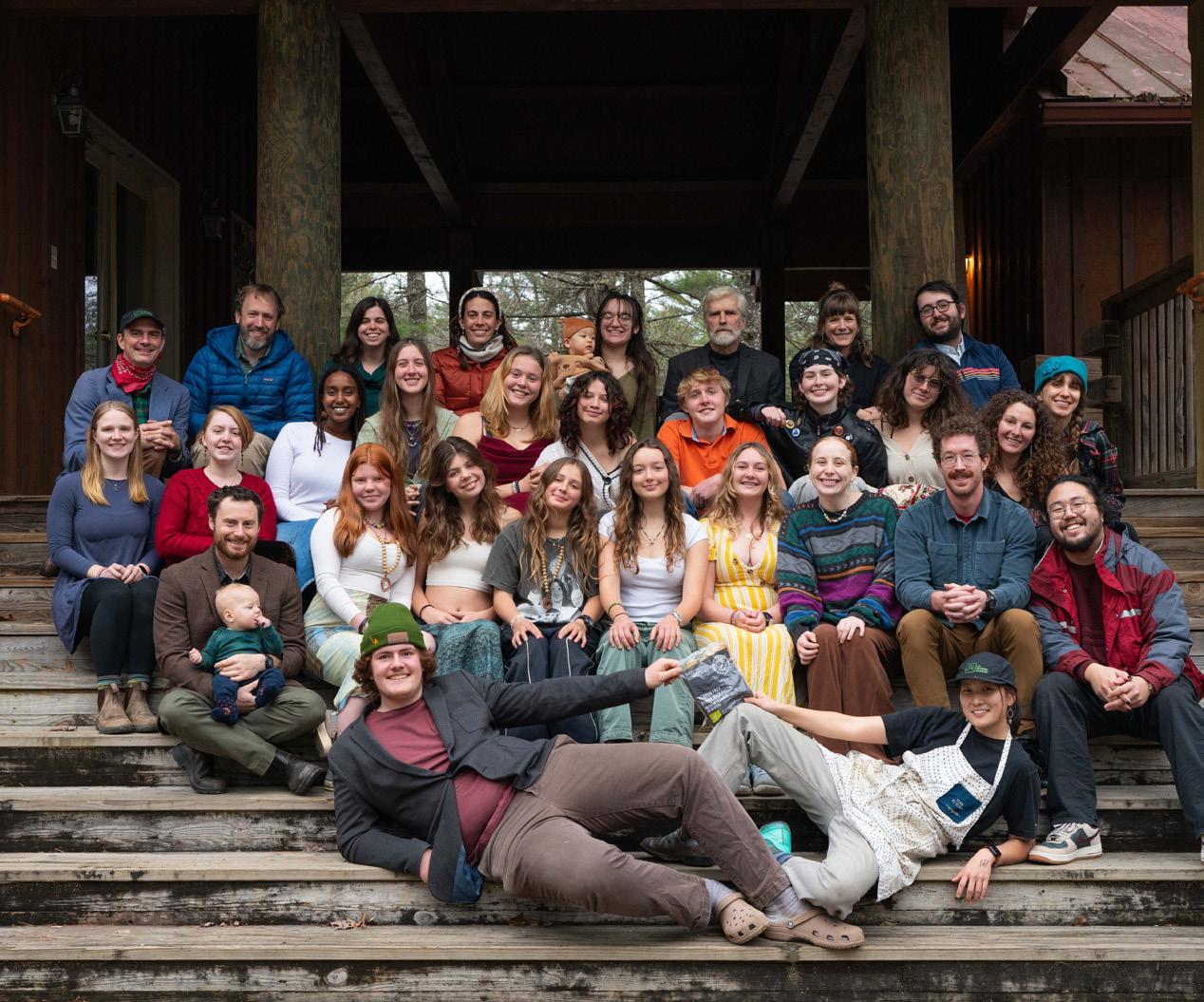
Scott Russell Sanders wrote in Staying Put (1993) that, “Riverness -- the appeal of a river, the way it speaks to us -- has to do with our craving for a sense of direction within the seeming randomness of the world. Narrative offers us the same pleasure, a shape and direction imposed on time. And so we tell stories and listen to them as we listen to the coursing of water.” Our story post-Helen is certainly one of connection and community: our staff and student reliance on each other in those isolated days after the storm cut us off from the surrounding world, our sojourn into the Little River Valley to share drinking water and to help clean up flood debris on a neighbor’s farm, and our student trip to the River Arts District to hear and celebrate Asheville stories at The Moth story-telling event just six weeks after the storm and floods. Maya, a Semester 59 student from Asheville, was randomly selected to share her story on stage that night. She beautifully recounted her experience of the storm and the difficulty of being away from home when home was being hard hit by Helene. Her narrative celebrated the joyful
moments of her childhood in a riverside park filled with family and play and celebration. “I hear the river, and my family. The people I love.” she said. Even in the overwhelming losses to the French Broads floodwaters, Maya found connection to her community and to Where She’s From. “I love Asheville. I love these mountains. I love my park. This is my home.”
One year later, I’m on the bank of the Little River, watching the students of Semester 61 launch their paddling expedition from our campus to Asheville‘s River Arts District. None of these students experienced Helene here, but they are nonetheless bound to this place, this post-Helen watershed, and to the broad network that is The Outdoor Academy and Eagle’s Nest family. Their 40-mile journey will be an exercise in teamwork and in observation. They will chart impacts of the storm as they consider their relationship to each other, to this landscape, and to home. In so doing, this place, in many ways, becomes a part of Where They’re From.
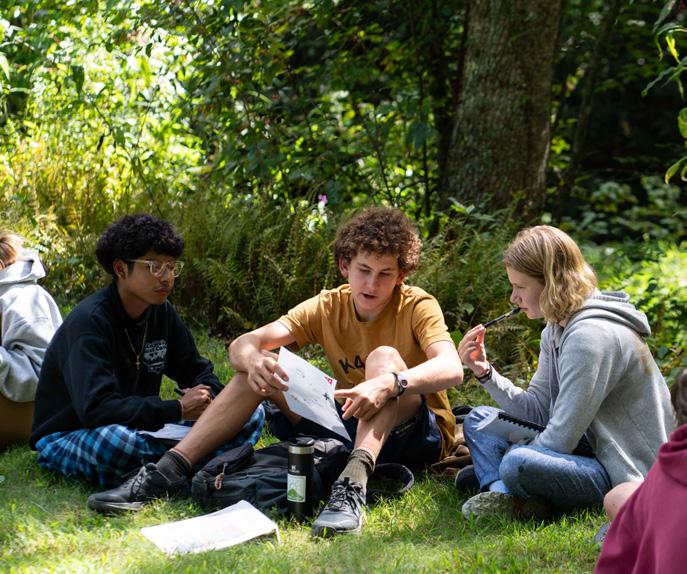
182
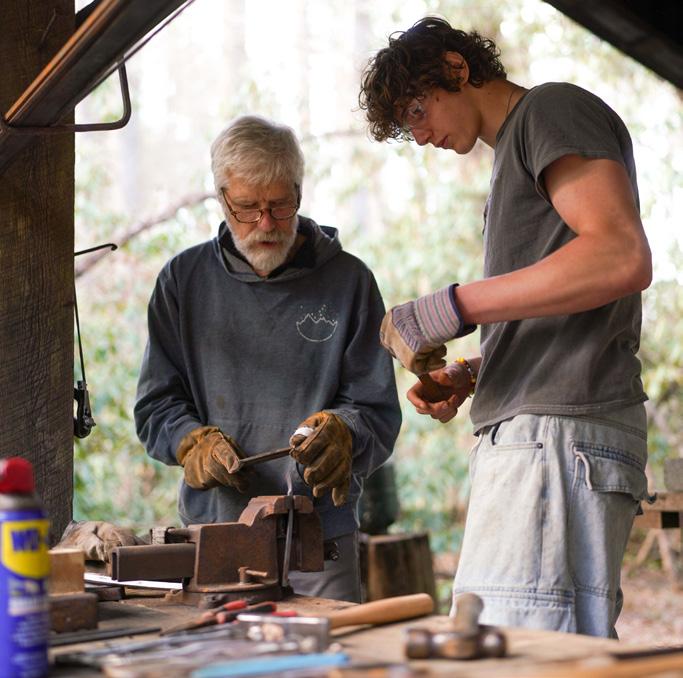
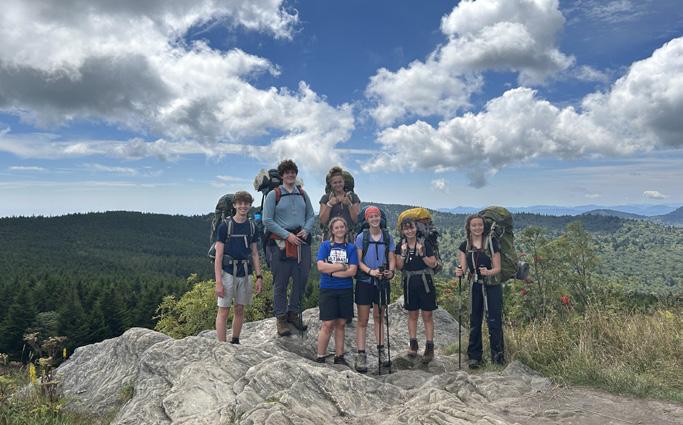
NEST CHATTER
News:
Jacob Goodman (Camp) will be attending Indiana University in fall 2025 where he was accepted into the Neuroscience program.
Jane’s Italy Trip: Heather and Beaver Goodling, Noni and Greg, Lyne and Kathryn Gamble, Will and MaryAnne, Jodi and Chuck Pippin
Park Inglefield (Camp and OA) is running for Mayor of Hickory NC.
“I’m running because I want to uplift the work that the City of Hickory and its leaders have done and to carry on their legacy. I have great respect for the projects and initiatives that have been ongoing under our current leadership. But I also see an opportunity for doing that work more responsibly, more transparently, and with new voices at the table.” Learn more: www.parkinglefield.com

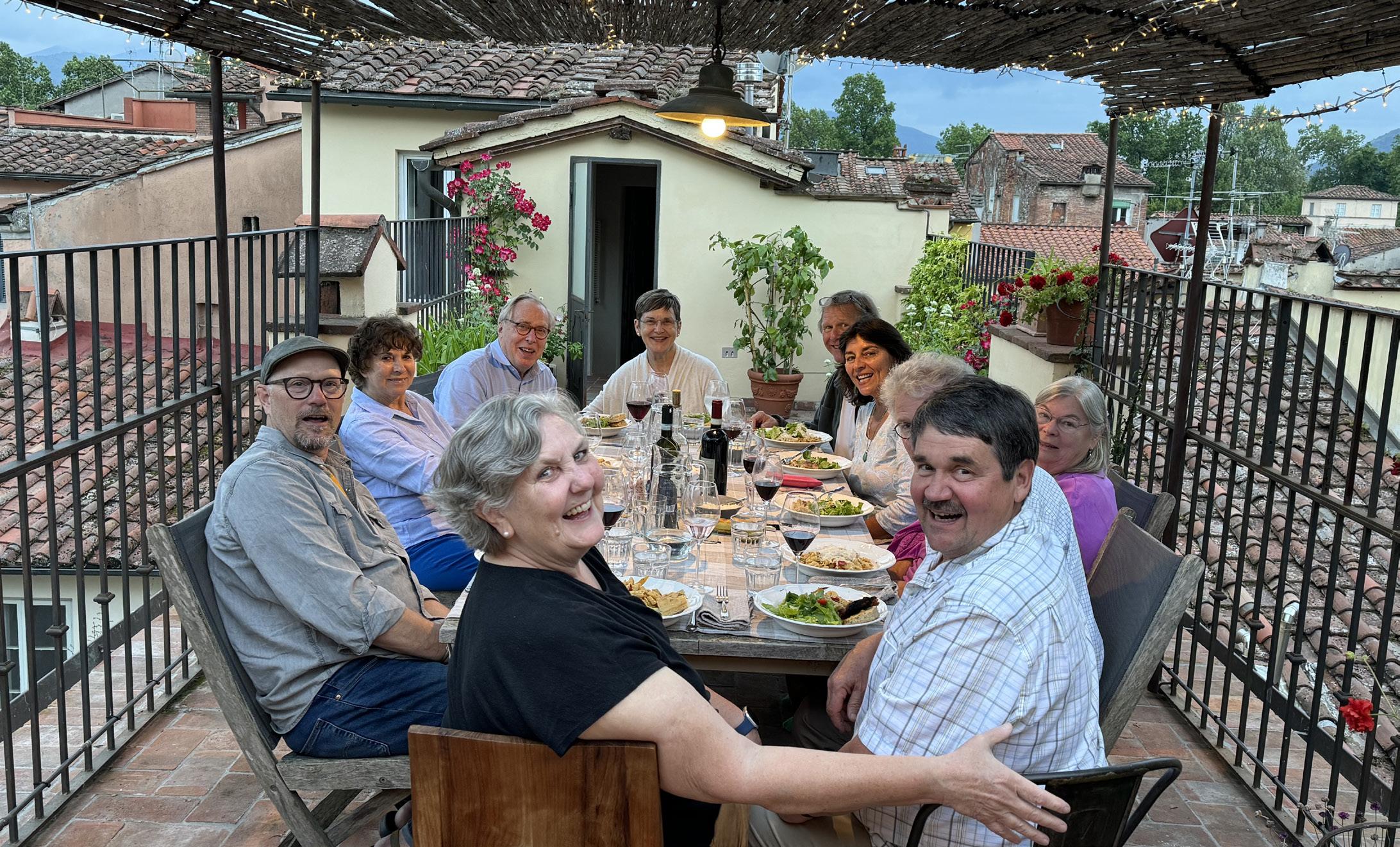
Jacob Goodman
Jane’s Italy Trip
Marriages:
Kathryn DeVillier (OA) married Andre LaBauve May 3rd, 2025 in Lafayette, Louisiana
Laurel Tollison (Camp & OA, Former Staff) married Jack Thorne June 21st, 2025.
Sara Post (Former Faculty) married Jeffrey Prado (Former Faculty) June 2025.
Erin Malone (Camp, Former Staff, Camp Parent) married Brian Guy (Camp Parent) June 21st, 2025 in Lincoln, Vermont. Erin asked her camp friends to lead a camp song singalong during the guest blessing of the rings. They sang Wild Mountain Thyme, Yellow Submarine, and You can Close Your Eyes. Jonathan and Eliza Romm, Cara Romanik, Jamey Lowdermilk, Zanne Garland, Roan Anderson, and Jackson Anderson all attended and ran a wedding day 5k!
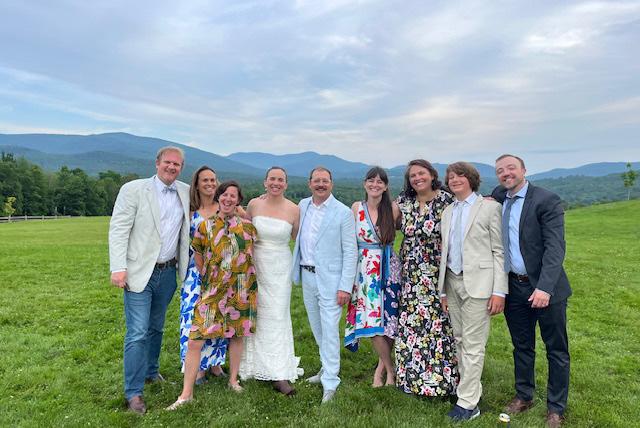
Babies:
Allison (Moore) Krehbiel (Former Staff, Camp & OA): baby Clara James born April 25th
Laura Kraus (Former Staff) and Joe Lovenshimer (Former Staff): baby Etta Louise born April 28th
Meredith Lobsinger (Former Staff) and Joe Karr: baby Zoe Rose born June 4th
Becca Doll (Former OA Staff) and Johan Taljaard (Former Staff): baby Sella Johanna born July 7th
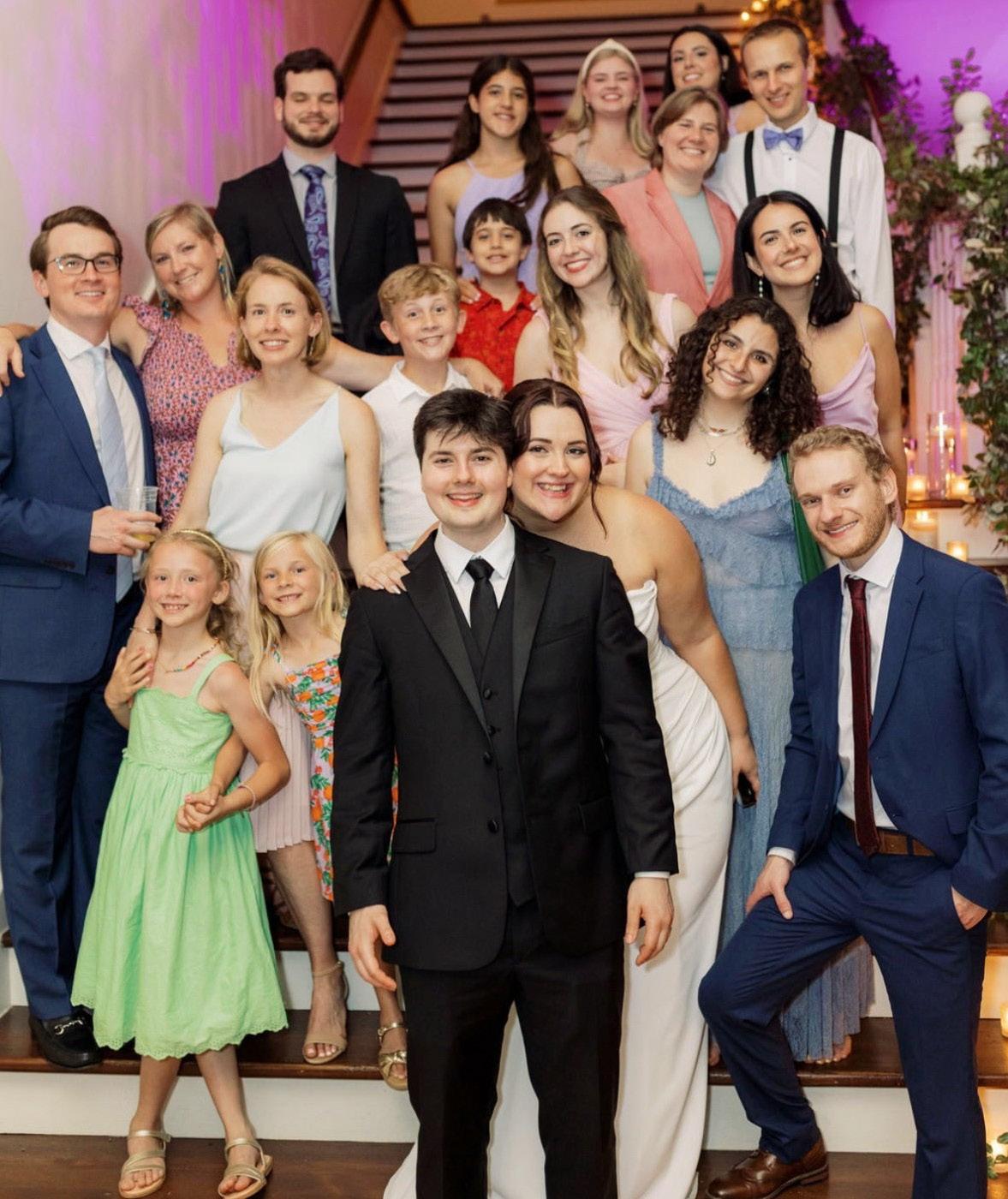
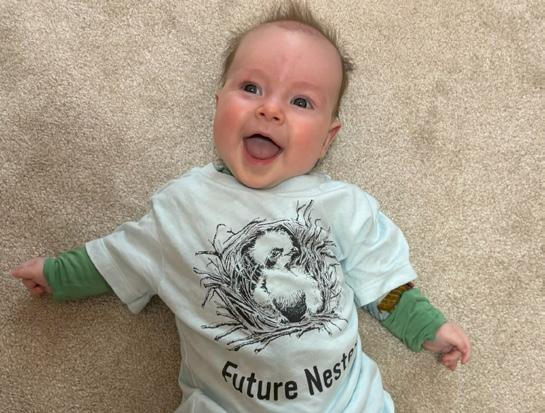
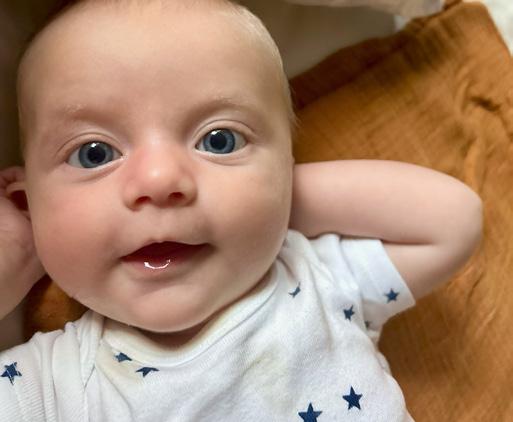
Passings:
Susan Gies Conley (Former ENF Development Director, Parent of Camp and OA) passed away surrounded by her family in Winston-Salem on June 21, 2025. www.salemfh.com/obituaries/Susan-Jean-GiesConley-Link?obId=43079633
Joann Fireman (Camp Parent and Grandparent) passed away in Mars Hill, NC on June 22, 2025.
Ann Ailor Thornton (Camp) passed away on August 25th, 2025. Ann attended camp for many years along with her siblings. Their mom was a nurse at camp.
www.bennettfuneralhomes.com/obituary/marthaann-ailor-thornton
Laurel & Jack
Erin & Brian
Baby Clara
Baby Etta
